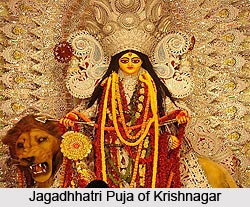 Krishnanagar is an important centre for culture and literature in West Bengal. During the downfall of independent Muslim Empire in Bengal and the advent of British and French East India Company, Krishnagar reached its height in art, literature, architecture and culture. Krishnagar reached its glory during the early rule of British East India Company, after the Battle of Plassey (1757).
Krishnanagar is an important centre for culture and literature in West Bengal. During the downfall of independent Muslim Empire in Bengal and the advent of British and French East India Company, Krishnagar reached its height in art, literature, architecture and culture. Krishnagar reached its glory during the early rule of British East India Company, after the Battle of Plassey (1757).
Krishnagar counts many literary figures such as Bharat Chandra Roy Gunakar of medieval era, Ramprasad Sen, one of spiritual leader in medieval Bengal, Dwijendralal Ray and Narayan Sanyal among many others. Ramprasad Sen was born into a Tantric family. He showed an inclination towards poetry from an early age. He became a disciple of Krishnananda Agamavagisha, a Tantric scholar and yogi. Ramprasad became well known for his devotional songs, eventually becoming the court poet for the king Krishna Chandra of Nadia. His life has been the subject of many stories depicting his devotion to, and relationship with, Goddess Kali. The literary works of Ramprasad Sen include Vidyasundar, Kali-Kirtana, Krishna-kirtana and Shaktigiti.
There is a vibrant culture of literary exchange among small groups of writers and poets. Sudhir Chakraborty was born here. Other notable writers of Krishnagar are Debdas Acharya and Subodh Sarkar. They are the writers and the poets of modern Bengali literature.
But some creative figures too honoured this ancient place and are those-Subhash Mukhopadhyay, Sudhir Chakraborty, Sanjib Pramanik, Debdas Acharya. There is also a strong tradition of stage acting.
Culture of Krishnagar also defines the clay modelling. It is locally known as "matir putul of Krishnanagar". Ghurni is the place of the production of clay modelling in Krishnagar. There is a colony of artists who work with clay. They were bought by the later medieval king of Krishnagar, Maharaja Krishnachandra from Bangladesh. These artists produce images of Hindu Gods and Goddesses for traditional worship throughout the year, as well as clay models of human figures and real life objects they make. Open studios and shops of the artists comprise an important attraction for the global tourists. It is said that initially it was Raja Krishnachandra who had settled a few families of talented clay artists in the area. Since then the colony has grown and flourished. Some of the artists have recently worked with other media as well.



















